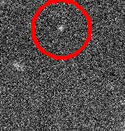
Image credit: University of Hawaii
Astronomers from the University of Hawaii have discovered six new moons for Jupiter, pushing the planet’s satellite count to 58 – the largest group of moons in the Solar System. These aren’t terribly big moons, though, only a kilometer or so across. The moons were discovered as part of an ongoing search using the world’s largest digital cameras at the Subaru and Canada-France-Hawaii telescopes atop Mauna Kea.
The majority of the new satellites were first seen in early February 2003 by Scott S. Sheppard and David C. Jewitt from the Institute for Astronomy, University of Hawaii along with Jan Kleyna of Cambridge University. The satellites were detected using the world’s two largest digital cameras at the Subaru (8.3 meter diameter) and Canada-France-Hawaii (3.6 meter diameter) telescopes atop Mauna Kea in Hawaii. Both telescopes and their imaging cameras represent the latest technology has to offer. Recoveries were performed at the University of Hawaii 2.2 meter with help from Yanga Fernandez and Henry Hsieh also from the University of Hawaii. Brian Marsden of the Harvard-Smithsonian Center for Astrophysics performed the orbit fitting for the new satellites.
The first 7 satellites were formally announced by the International Astronomical Union on Circular No. 8087 on March 4, 2003 while the eighth was announced on Circular No. 8088 on March 6, the 9th through 12th on Circular No. 8089 on March 7, S/2003 J13 through J20 were announced in April, and S/2003 J21 in May*. Except for S/2003 J20, all the new Jupiter satellites appear to have distant retrograde orbits (ie. their orbital rotation is opposite to Jupiter’s rotation) like the majority of the known irregular satellites of Jupiter. The satellite S/2003 J20 appears to be a prograde satellite dynamically distinct from any other known Jupiter satellite.
Original Source: IFA News Release
